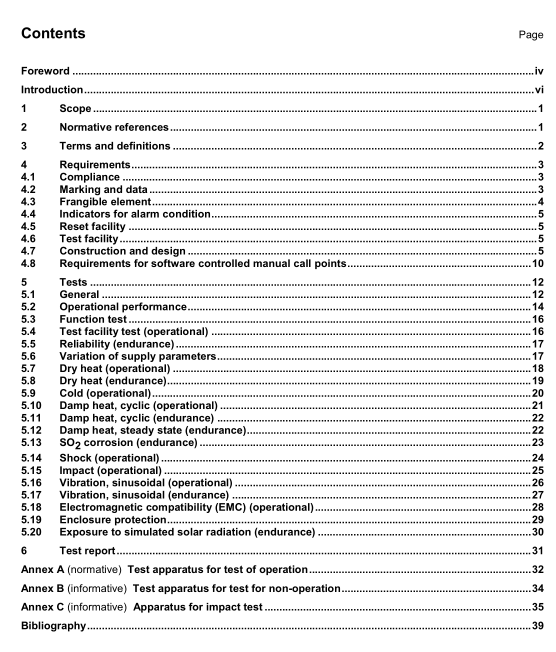ISO 7240 pdf download

ISO 7240 pdf download Fire detection and alarm systems — Part 11: Manual call points
4.7.3 Symbols and lettering
4.7.3.1 General The manual call point shall be marked, with the appropriate symbols shown in Figure 2, as specified in 4.7.3.2 and 4.7.3.3. Examples of the arrangement of symbols on type A and type B manual call points are given in Figures 3 and 4, respectively.
4.7.3.2 Symbols and lettering on the front face 4.7.3.2.1 On the front face above the operating face and central to the vertical centre line shall be the symbol in accordance with Figure 2 a). This symbol may be supplemented with the word “FIRE”, or equivalent words in the national language. This combination shall be on the front face and above the operating face and central to the vertical centre line. The height of the symbol shall be at least 0,15a and the height of the lettering shall not exceed the height of the symbol. The lettering shall be in accordance with ISO 3098-0:1997, “lettering type B, vertical (V)”. Symbols and lettering shall be white in accordance with ISO 3864-1.
4.7.3.2.2 Markings other than specified in 4.7.3.2.1 (such as company logo or contact address) shall be restricted to the area of the front face below the horizontal centre line of the operating face. The total area for this marking other than red shall not be greater than 5 % of the area of the front face.
4.7.3.3 Symbols and lettering on the operating face 4.7.3.3.1 The operating face of type A manual call points shall be marked with the symbol in accordance with Figure 2 c). The operating face of type B manual call points shall be marked with the symbols in accordance with Figures 2 b) and 2 c). The symbol in accordance with Figure 2 b) shall point to the operating element and shall remain clearly visible when the frangible element is broken or displaced. These symbols may be supplemented by appropriate words for instruction. Where supplementary wording is used, this shall indicate position and/or operating action (e.g. “PRESS HERE”), in the appropriate language. These symbols and lettering for any supplementary instructions shall be black, with the black area not exceeding 10 % of the area of the operating face. NOTE A suitable black colour is specified in ISO 3864-1.
4.7.3.3.2 Markings other than those specified in 4.7.3.3.1 (such as company logo or contact address) shall be restricted to the upper and/or the lower 25 % of the area of the operating face and shall not interfere with the symbols. The total area for this marking other than white shall not be greater than 5 % of the area of the operating face.
4.7.4 Protection against accidental operation
4.7.4.1ln addition to the use of the frangible element, other means of protection may be used, e.g.atransparent flap.
4.7.4.2Where used, the protection shall be easily and immediately removable and shall have clearinstructions for its removal in order to operate the manual call point.
4.7.4.3 With the protection in place,the appearance of the manual call point, the instructions for itsoperation and the state of the manual call point in the normal and alarm condition shall be clearly visible.
4.7.5 Environment category
4.7.5.1 The environment category (i.e. indoor or outdoor use, special environmental conditions) of themanual call point shall be specified by the manufacturer.
4.7.5.2 The manual call point shall be tested in accordance with the specified environmental category asgiven in the test schedule in Table 1.
4.8Requirements for software controlled manual call points
4.8.1 General
For manual call points that rely on software control, the requirements of 4.8.2,4.8.3 and 4.8.4 shall be met inorder to fulfil the requirements of this part of ISo 7240.
4.8.2Software documentation
4.8.2.1 The manufacturer shall submit documentation that gives an overview of the software design. Thisdocumentation shall be in sufficient detail that the design can be inspected for compliance with this part oflSo 7240 and shall include at least the following:
a) functional description of the main program flow (e.g.as a flow diagram or schema), including
1) a brief description of the modules and the functions that they perform,
2) the way in which the modules interact,









